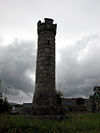A834
| A834 | ||||||||||
| Location Map ( geo) | ||||||||||
| ||||||||||
| From: | Dingwall (NH546587) | |||||||||
| To: | Contin (NH457557) | |||||||||
| Distance: | 6.8 miles (10.9 km) | |||||||||
| Meets: | A862, A835 | |||||||||
| Former Number(s): | B862, B9162 | |||||||||
| Old route now: | A835 | |||||||||
| Highway Authorities | ||||||||||
| Traditional Counties | ||||||||||
| Route outline (key) | ||||||||||
| ||||||||||
Route
The A834 is approximately 7 miles long and currently covers almost exactly the same route that it did when first classified in 1922. However, for a very few years it was extended to Tore Roundabout on the A9, via what is now the A835.
Dingwall - Contin
The A834 commences at its eastern end at a traffic-light-controlled junction with the A862 (former A9) in Dingwall, facing the pedestrianised High Street, which was once part of the route. It then heads west, first as Burn Place, then turning north along Mill Street to cross the railway line on a level crossing. Turning westwards once more, it becomes Strathpeffer Road and passes the Docharty area of the town and Industrial Estates, running between the railway to the south and the little River Peffery to the north.
Leaving Dingwall behind, the road follows a long and level straight before curving to pass underneath a railway bridge close to the site of Fodderty Junction. This was the start of the former Strathpeffer railway branch line, which closed to passengers in 1946, and completely in 1951, although the railway station in Strathpeffer is still intact and in use as a series of small shops. After the railway bridge the road starts to climb gently, and a series of shorter straights leads the road through Fodderty, a name given to a scattering of settlements along and above the road. This is Strath Peffer - the wide valley of the River Peffery, and at Blairninich the road crosses the river - although you would hardly notice! Climbing up from the wide valley floor to the north are steep sides covered in a patchwork of squarish fields, and dotted with houses, a reminder that this is not yet the 'proper' Highlands, but still the lush pasture land of the Moray Firth. To the south is the steep-sided Knock Farrill, with the remains of a hill fort on its summit, commanding a superb view.
From Blairninich, the road turns southwards and runs into Strathpeffer, a once thriving Victorian Spa Town, which after a quieter period has revived as a popular stopping place for coach tours and holidaymakers, with shops, hotels and museums surrounded by forest walks and all within easy reach of both Inverness and the scenic splendour of Wester Ross. The town is well worth a stop, with the famous Strathpeffer Pavillion still host to a variety of events through the course of the year. The road climbs more steeply through the town, and heading south as it leaves the town, it crosses its summit at 106m. Becoming windier than before, it meanders through farmland with scattered roadside houses to Jamestown, a small settlement set just off the road.
With just over a mile to go, the road curves westwards once more, dropping steadily down the hill as it passes a left turn that leads down to the A835, effectively a short cut for traffic heading back towards Inverness. The road straightens up before coming to its end at a triangular junction with the A835 (former A832) at the southern end of the small village of Contin.
History
The original start point of the A834 was two hundred yards or so further east, along Dingwall High Street at the junction with Tulloch Street, the former route of the A9. This situation persisted until the A9 was rerouted in 1982, when Tulloch Street became part of the A862, although in the mean time Dingwall had become so congested that maps from the 1970s show several of the town's streets as A roads, without being numbered, so the A834 may have briefly included a 'spur' as the transport planners tried to guide traffic through the town. The Dingwall relief road, the current route of the A862, was created later, but the precise date is not currently known.
For a very brief period in the early 1980s the A834 was extended, after a brief multiplex with the A862 (former A9), along the Conon Bridge bypass to Tore Roundabout. This is shown on the 1981 edition of the OS Landranger map. However, it was not long before the Maryburgh Bypass was added, along with the new road to Marybank. This led to the extension of the A835 from Garve all the way to its current terminus at Tore Roundabout and the A834 was truncated back to its original route.
The original route was made a trunk road in 1946 (rather than the more direct - for long distance traffic - A832 from Muir of Ord) and remained so until the modern A835 had been completed a few miles further south.
| A834 | ||||
| ||||
| ||||
| ||||
| ||||
| ||||
|




